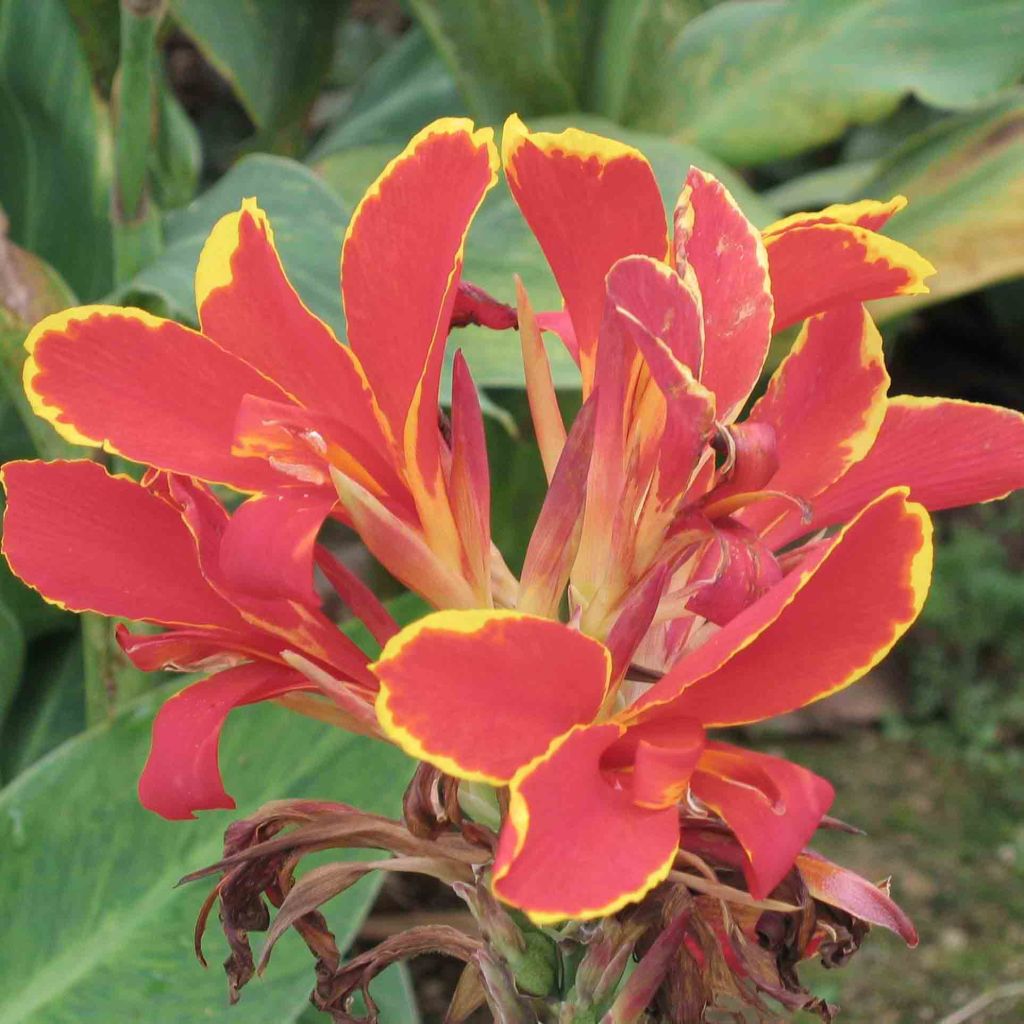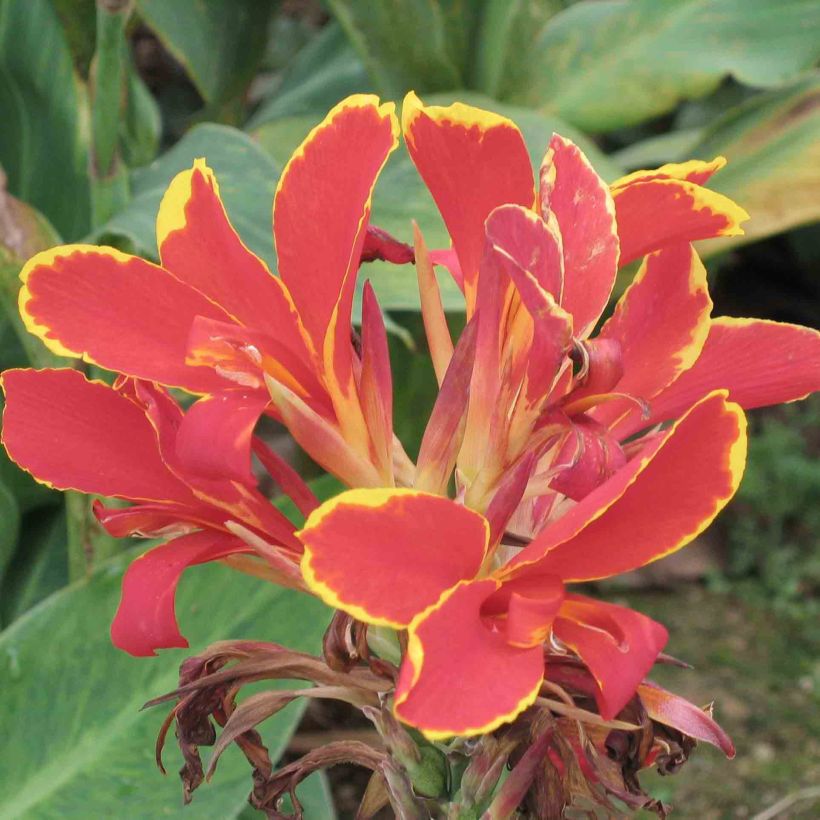

Canna Lucifer - Balisier nain à fleurs rouge liséré de jaune d'or et à feuillage vert moyen.
Canna Lucifer - Indian shot
Canna x indica Lucifer
Indian shot, Canna, Cann Lily, African Arrowroot, Edible Canna, Purple Arrowroot, Sierra Leone Arrowroot
Very beautiful canna, still in bloom in November! We're going to bring it indoors for the winter. We really loved this canna. Thank you very much!
CHRISTINE, 05/11/2023
Special offer!
Receive a €20 voucher for any order over €90 (excluding delivery costs, credit notes, and plastic-free options)!
1- Add your favorite plants to your cart.
2- Once you have reached €90, confirm your order (you can even choose the delivery date!).
3- As soon as your order is shipped, you will receive an email containing your voucher code, valid for 3 months (90 days).
Your voucher is unique and can only be used once, for any order with a minimum value of €20, excluding delivery costs.
Can be combined with other current offers, non-divisible and non-refundable.
Home or relay delivery (depending on size and destination)
Schedule delivery date,
and select date in basket
This plant carries a 6 months recovery warranty
More information
We guarantee the quality of our plants for a full growing cycle, and will replace at our expense any plant that fails to recover under normal climatic and planting conditions.

Would this plant suit my garden?
Set up your Plantfit profile →
Description
Canna 'Lucifer' is a dwarf variety. It bears an abundance of bright red flowers edged in golden yellow. It is particularly suitable for pot or container cultivation in small gardens. This rhizomatous perennial has an exotic appearance. In spring, it bears lush foliage that is slightly undulating. It is medium green with blue highlights. This canna lily blooms abundantly from July to October in erect terminal clusters of flamboyant flowers, beautifully contrasting with the texture and fresh colour of the foliage. It is a frost-tender perennial that needs to be stored away in regions prone to frost, just like dahlias. Plant it in a warm, sunny location, in moist but well-drained rich soil.
Canna 'Lucifer' is a horticultural hybrid, belonging to a large group of hybrid cannas of unknown or complex lineage, all of which originate from tropical and subtropical regions of the Americas. This plant belongs to the Cannaceae family, and to the same group as gingers and bananas. In spring, its thick and knotty rhizome develops a dense clump, 60cm (24in) tall and 50cm (20in) wide, composed of numerous large entire leaves whose sheathing base forms a false stem. The colour of the laminae is a medium green tinged with blue. From July to October, thin floral stems appear at the centre. The asymmetric flowers are grouped in dense spikes, with bright red petals edged with golden yellow. The dry vegetation disappears at the end of the season, while the plant enters dormancy. Canna rhizomes are sensitive to frost, and prefer to spend winter in fairly dry soil. Leaving them in the ground during winter is only possible in our mildest regions, with a thick protective mulch.
Hybrid cannas are majestic and colourful plants, ideal for adding interest to the back of borders for taller varieties, or for brightening up patios and balconies for more compact varieties. Growing them is within everyone's reach. Consider planting them in dense flower beds of about ten bulbs of the same variety, or by mixing green and purple foliage. Canna 'Lucifer' can be used to create stunning exotic-looking container displays, alongside agapanthus, amaranths, and cosmos. It forms a beautiful combination with a banana plant or bamboo. Grow this plant like a dahlia. Dig up the rhizomes before the frost arrives and replant them in spring.
Report an error about the product description
Canna Lucifer - Indian shot in pictures


Plant habit
Flowering
Foliage
Botanical data
Canna
x indica
Lucifer
Cannaceae
Indian shot, Canna, Cann Lily, African Arrowroot, Edible Canna, Purple Arrowroot, Sierra Leone Arrowroot
Cultivar or hybrid
Other Cannas
View all →Planting and care
Plant the bulbs after the last frosts. The soil should be moist but well-drained (if necessary, lighten your soil with turf or sand). Space them 40cm (16in) apart. Cover with 5cm (2in) of soil. Apply organic fertiliser at planting and at least once a month. Water regularly so that the soil never completely dries out. Its flowering will be more beautiful if it is planted in partial shade.
It does not like cold weather. It must be protected from frost during winter. Dig up the rhizomes and keep them dry and cool. You can place them in turf, for example.
You can speed up their cycle by planting them in pots under frost-free shelter as early as February, and then transplanting them to the garden in warmer weather.
Planting period
Intended location
Care
-
, onOrder confirmed
Reply from on Promesse de fleurs
Haven't found what you were looking for?
Hardiness is the lowest winter temperature a plant can endure without suffering serious damage or even dying. However, hardiness is affected by location (a sheltered area, such as a patio), protection (winter cover) and soil type (hardiness is improved by well-drained soil).

Photo Sharing Terms & Conditions
In order to encourage gardeners to interact and share their experiences, Promesse de fleurs offers various media enabling content to be uploaded onto its Site - in particular via the ‘Photo sharing’ module.
The User agrees to refrain from:
- Posting any content that is illegal, prejudicial, insulting, racist, inciteful to hatred, revisionist, contrary to public decency, that infringes on privacy or on the privacy rights of third parties, in particular the publicity rights of persons and goods, intellectual property rights, or the right to privacy.
- Submitting content on behalf of a third party;
- Impersonate the identity of a third party and/or publish any personal information about a third party;
In general, the User undertakes to refrain from any unethical behaviour.
All Content (in particular text, comments, files, images, photos, videos, creative works, etc.), which may be subject to property or intellectual property rights, image or other private rights, shall remain the property of the User, subject to the limited rights granted by the terms of the licence granted by Promesse de fleurs as stated below. Users are at liberty to publish or not to publish such Content on the Site, notably via the ‘Photo Sharing’ facility, and accept that this Content shall be made public and freely accessible, notably on the Internet.
Users further acknowledge, undertake to have ,and guarantee that they hold all necessary rights and permissions to publish such material on the Site, in particular with regard to the legislation in force pertaining to any privacy, property, intellectual property, image, or contractual rights, or rights of any other nature. By publishing such Content on the Site, Users acknowledge accepting full liability as publishers of the Content within the meaning of the law, and grant Promesse de fleurs, free of charge, an inclusive, worldwide licence for the said Content for the entire duration of its publication, including all reproduction, representation, up/downloading, displaying, performing, transmission, and storage rights.
Users also grant permission for their name to be linked to the Content and accept that this link may not always be made available.
By engaging in posting material, Users consent to their Content becoming automatically accessible on the Internet, in particular on other sites and/or blogs and/or web pages of the Promesse de fleurs site, including in particular social pages and the Promesse de fleurs catalogue.
Users may secure the removal of entrusted content free of charge by issuing a simple request via our contact form.
The flowering period indicated on our website applies to countries and regions located in USDA zone 8 (France, the United Kingdom, Ireland, the Netherlands, etc.)
It will vary according to where you live:
- In zones 9 to 10 (Italy, Spain, Greece, etc.), flowering will occur about 2 to 4 weeks earlier.
- In zones 6 to 7 (Germany, Poland, Slovenia, and lower mountainous regions), flowering will be delayed by 2 to 3 weeks.
- In zone 5 (Central Europe, Scandinavia), blooming will be delayed by 3 to 5 weeks.
In temperate climates, pruning of spring-flowering shrubs (forsythia, spireas, etc.) should be done just after flowering.
Pruning of summer-flowering shrubs (Indian Lilac, Perovskia, etc.) can be done in winter or spring.
In cold regions as well as with frost-sensitive plants, avoid pruning too early when severe frosts may still occur.
The planting period indicated on our website applies to countries and regions located in USDA zone 8 (France, United Kingdom, Ireland, Netherlands).
It will vary according to where you live:
- In Mediterranean zones (Marseille, Madrid, Milan, etc.), autumn and winter are the best planting periods.
- In continental zones (Strasbourg, Munich, Vienna, etc.), delay planting by 2 to 3 weeks in spring and bring it forward by 2 to 4 weeks in autumn.
- In mountainous regions (the Alps, Pyrenees, Carpathians, etc.), it is best to plant in late spring (May-June) or late summer (August-September).
The harvesting period indicated on our website applies to countries and regions in USDA zone 8 (France, England, Ireland, the Netherlands).
In colder areas (Scandinavia, Poland, Austria...) fruit and vegetable harvests are likely to be delayed by 3-4 weeks.
In warmer areas (Italy, Spain, Greece, etc.), harvesting will probably take place earlier, depending on weather conditions.
The sowing periods indicated on our website apply to countries and regions within USDA Zone 8 (France, UK, Ireland, Netherlands).
In colder areas (Scandinavia, Poland, Austria...), delay any outdoor sowing by 3-4 weeks, or sow under glass.
In warmer climes (Italy, Spain, Greece, etc.), bring outdoor sowing forward by a few weeks.

































